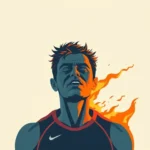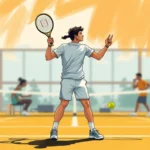Iga Swiatek, the undisputed queen of the WTA tour, has captivated audiences with her dominant performances, particularly on clay. However, even the most formidable players face challenges, and Swiatek is no exception. Recently, her coach, Wim Fissette, has openly discussed a crucial aspect of her game that occasionally goes “missing” during matches: her serve.
The Serve Under Scrutiny
Fissette’s remarks highlight the ongoing efforts to refine Swiatek’s serve, acknowledging that while progress is evident in training, translating that improvement to match-day performance remains a work in progress. “After Miami, we made some adjustments to the preparation of the serve,” Fissette stated, pinpointing a specific period of focus. He elaborated, “During the training on the court, it works very well. In the match with Jelena Ostapenko, Iga was a bit tense at the beginning. When she entered the match, it was much better.”
This observation underscores the mental aspect of the game, suggesting that pressure and nerves can impact Swiatek’s ability to execute her serve consistently. The serve, often considered the foundation of a player’s game, can significantly influence momentum and dictate the flow of a match.
Consistency is Key
The challenge, as Fissette points out, lies in achieving consistency. “In some matches, she served very well, in others, the first serve was missing,” he explained. This fluctuation in performance is a concern that the team is actively addressing. “So, this element fluctuates, and it is normal that we pay a lot of attention to it. We spent a lot of time on it. It is definitely something that we would all like to see improvement in. We work on it every day.”
The daily dedication to improving her serve demonstrates Swiatek’s commitment to continuous development and her willingness to address perceived weaknesses in her game.
Macci’s Analysis: A Call for Biomechanical Adjustments
Adding another layer to the conversation, Rick Macci, Serena Williams’ former coach, has weighed in on Swiatek’s serve. Macci believes a biomechanical adjustment could significantly enhance her performance. He noted that players who play a clean and flat game can exploit Swiatek’s second serve, leading to more frequent breaks. Macci emphasized, “Iga will be ok on clay, but her serve has remained unchanged for years. If modified, it could yield more free points and add power to her second serve.”
Macci’s perspective highlights the technical aspects of the serve and suggests that even minor adjustments can have a substantial impact on its effectiveness.
Swiatek’s Struggles Against Ostapenko
Swiatek’s struggles against Jelena Ostapenko further emphasize the importance of a reliable serve. Ostapenko’s aggressive style of play has consistently challenged Swiatek, and their recent clashes have exposed vulnerabilities in her first serve. Swiatek has a losing record against Ostapenko, and she has yet to find a solution to beating her.
Fissette’s Proven Track Record
Fissette, known for his work with top players like Naomi Osaka, brings a wealth of experience to the table. His attention to technical detail and ability to build mental resilience are expected to be key assets as Świątek navigates the demanding season.
Fissette’s coaching history demonstrates his ability to elevate players’ games and help them achieve significant success. His expertise in both technical and mental aspects of tennis makes him a valuable asset to Swiatek’s team.
The Mental Game
Fissette’s insights also shed light on the mental challenges faced by top athletes. He acknowledges that pressure and expectations can sometimes hinder performance, particularly when executing crucial shots like the serve. By addressing the mental aspect of the game, Fissette aims to help Swiatek maintain composure and confidence in high-pressure situations.
Staying True to Her Game
Fissette has also emphasized the importance of Swiatek staying true to her game, particularly against big hitters. “In general, say outside of the clay, I think she feels sometimes that she really has to change her game too much. So when she plays against big hitters, she feels maybe she has to hit bigger than them; where I feel like she has to stay a little bit more true to her game and use her weapons, like the heavy spin. There’s no need to go flat,” he explained. This suggests a focus on maintaining her unique strengths rather than trying to emulate her opponents.
Specific Areas of Improvement
Fissette has identified specific areas where he aims to improve Swiatek’s game. “For me, I think the forehand is a weapon, but I want to make it already a bigger weapon, and maybe be a little bit stronger also in defence and improve a little bit the serve, like more speed, more precision. That’s the goal.” These targeted improvements demonstrate a strategic approach to refining Swiatek’s overall game.
Swiatek’s Former Coach
Iga Swiatek parted ways with coach Tomasz Wiktorowski, as she seeks to elevate her career to the next level. She developed significantly under his tutelage, winning 4 of her 5 Grand Slams under Wiktorowski and 19 of her 22 career titles. She also reached world No. 1 shortly after Wiktorowski was hired and reeled off the longest winning streak on the WTA Tour this century.
Potential Reasons for Split
While both Iga and Tomasz have denied any bad blood between them, a lot of theories are in the air, one of them being Iga’s Psychologist Daria Abramowicz’s role in the split. But Lech Sidor, tennis coach and Eurosport commentator has a different take on it, drawing parallels with Wiktorowski’s previous split with former World No. 2 Agnieszka Radwańska.
Sidor drew a parallel with Wiktorowski’s time with Radwańska. “There remains the issue of professional burnout. Even Iga herself said that now it’s time for a coach to rest, that he deserves a long vacation, etc.,” Sidor reminded in the Eurosport Podcast, as reported by Sport.pl.
The Road Ahead
As Swiatek prepares for upcoming tournaments, the focus on improving her serve remains a top priority. With Fissette’s guidance and her unwavering dedication, Swiatek aims to transform this “missing” weapon into a consistent strength, solidifying her position as a dominant force in women’s tennis.
Clay Court Dominance
Last season, Swiatek boasted a remarkable 21-1 record on clay, with Elena Rybakina being the sole player to defeat her. Looking ahead, Swiatek aims to defend a substantial number of ranking points, a daunting task that requires replicating her dominant 2024 clay season. Her focus remains steadfast as she gears up for the clay swing, stating, “I don’t want to dwell on past losses. I’m eager to play on clay and will work hard to be ready for the early tournaments.”
Overcoming Challenges
This season has been marked by a series of setbacks for Swiatek. Despite reaching her first Australian Open semifinal in January, she fell to eventual champion Madison Keys. Subsequent tournaments saw her exit in the quarterfinals and semifinals, often against formidable opponents like Jelena Ostapenko and Mirra Andreeva, both of whom have posed consistent challenges. However, Eala’s victory over Swiatek is particularly noteworthy.
Swiatek’s New Coach
Wim Fissette became Swiatek’s new coach as she is preparing for the WTA Finals. Fissette has previously worked with Angelique Kerber and several other elite players. The German won Wimbledon under his guidance in 2018. The 44-year-old also helped develop the career of Naomi Osaka, who won the US Open in 2020 and the Australian Open in 2021.
Looking Ahead to Madrid
As Świątek heads into Madrid, she will face a tough opponent in her very first match – Alexandra Eala. Alexandra made headlines when she defeated Iga Swiatek at the Miami Open earlier this year. As Iga looks to build her serve and momentum, as the clay court swing gathers momentum, she is still on the hunt for her first title in Madrid.








No Comment! Be the first one.